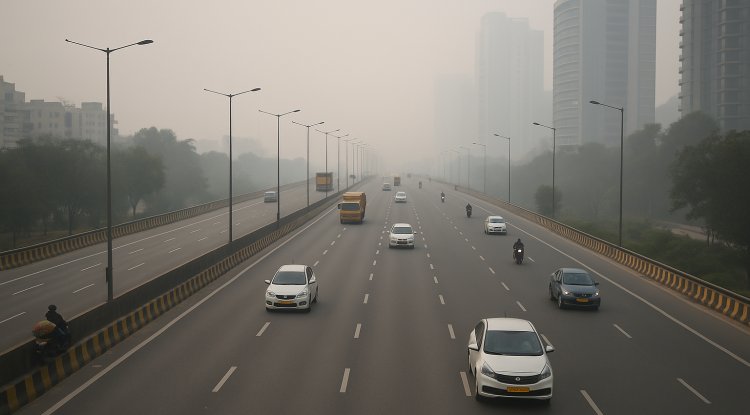Climate Risk Assessment Is No Longer Optional For Businesses
In a world where resilience and adaptability define success, the companies that lead on climate will be the ones that thrive, writes the author

When Climate Corps Fellow Amruth Chinnappa began his project with Larsen & Toubro in 2023, he didn't expect he would be mapping how climate change could impact one of India's largest multinational conglomerates. He had to conduct a climate scenario analysis-a tool that's increasingly becoming essential in understanding how climate change could affect business operations and its survival.
Amruth's experience is an example of a growing reality: companies across India are being asked not just to track their emissions, but to anticipate climate risk. And that's where Climate Risk Assessment (CRA) comes in.
In recent years, the need for CRA has been amplified by regulatory pressure and investor scrutiny. Investors now demand transparency in how companies manage climate risks, making it essential for businesses to conduct rigorous assessments and implement mitigation strategies.
The World Economic Forum reported that climate change is costing the world $16 million per hour. Such headlines often tend to spur action more effectively than abstract existential threats. And here's where experts have pushed for CRA; a field once confined to niche environmental discussions has now become central to corporate strategy and government policy.
It's Not Just About Melting Ice Caps Anymore
Climate change isn't some distant threat looming on the horizon-it's already hitting home. It's showing up in flooded warehouses, scorched supply chains, and rising insurance premiums. For businesses, this isn't just an environmental issue-it's a financial one. Red balance sheets, changing regulations, and anxious investors are making it clear: the cost of ignoring climate risk is growing.
So, What Exactly is Climate Risk Assessment (CRA)?
Think of Climate Risk Assessment as a way for companies to answer some tough but essential questions:
How exposed are we to climate disasters?
What happens if carbon pricing kicks in?
Are we ready if policies or technologies change suddenly?
CRA looks at two main types of risks. First, physical risks-things like floods, storms, and extreme heat that can directly hit operations. Then there are transition risks-the ones that come from shifts in government policy, new technologies, or changing customer expectations as we move towards a low-carbon world.
Why This Matters for Business
Understanding these risks isn't just about good citizenship-it's about survival and long-term success. Investors want to see that companies are prepared, and CRA helps them prove it. One key tool is climate scenario analysis, often guided by global frameworks like the Task Force on Climate-related Financial Disclosures (TCFD). These models help businesses imagine what different climate futures might look like and plan accordingly.
Turning Insight Into Action: Still a Work in Progress
Here's the catch: knowing the risks is one thing, acting on them is another.
Many companies still struggle to weave CRA into their business strategy. A 2021 Ernst & Young report showed that only 26% of surveyed companies quantitatively assess physical climate risks-and just 33% evaluate transition risks. That gap highlights a core challenge: turning long-term climate data into short-term, concrete financial strategies.
Bottom line? The clock is ticking. Understanding climate risk isn't optional anymore-it's a critical part of staying in business.
CRA is deeply industry-specific. An SUV manufacturer, for instance, faces different climate threats than an agricultural business. Companies typically rely on worst-case scenario analyses using frameworks created by global bodies such as the Intergovernmental Panel on Climate Change (IPCC) and International Energy Agency (IEA).
Businesses that integrate climate risk assessments effectively gain a strategic advantage. An article published by EY in 2024 shows that businesses that incorporate climate resilience into their strategies can create long-term value and respond effectively to the climate crisis.
CRA isn't just a technical exercise-it's a business strategy challenge. Successful implementation depends on securing buy-in from plant heads, CFOs, R&D teams, and strategy departments. However, resistance is common because decision-makers often underestimate long-term climate risks in favour of short-term financial goals. The World Economic Forum emphasizes that business leaders must act swiftly to decarbonise operations and build resilient value chains to adapt to climate risks.
India's Policy Push: Can Government Drive Widespread Climate Risk Adoption?
A WTW Report indicates that companies in India require the right expertise in managing climate risks, a conducive regulatory environment, and better data availability to undertake climate-related financial reporting. Experts opine that barriers such as knowledge gaps, financing, and policy bottlenecks may hinder large-scale adoption of climate risk frameworks.
The Indian government, slowly and steadily, is making policies and frameworks that will push industries toward better risk management. For instance, it has introduced a slew of measures to curtail emissions. It is working on newer avenues of alternative clean fuels and introducing measures to have greater penetration of renewable energy. NITI Aayog is currently developing a nationwide climate risk assessment tool to map vulnerabilities at a granular level.
The Climate Reckoning: Adapt or Be Left Behind
The message is clear: assessing climate risks is not about compliance-it's about survival. According to an analysis of S&P Global ESG data, nearly 40% of India-based companies conduct physical risk assessments, while one-third of large firms rank climate strategy among their top three material priorities. The numbers shown here point to an optimistic tone but still there's a lot of work that needs to be done.
Some recent reports highlight the steps taken by a few companies to future-proof their business. Outlook Business in its report 'Godrej to Zomato: Extreme Weather Events Show India Inc. is Struggling to Deal With Climate Change' covered how new-age start-ups and legacy companies are addressing climate change. Likewise, another article by EY from 2024 reported how Dabur is 'boosting operations productivity through sustainability-led business transformation'.
The future belongs to businesses that prepare for it. As climate tipping points draw closer, the cost of inaction is steep-financial instability, fractured supply chains, and mounting regulatory pressure. Yet, those who integrate climate risk assessment today are not just safeguarding their bottom line; they are shaping the future of corporate sustainability.
In a world where resilience and adaptability define success, the companies that lead on climate will be the ones that thrive. The question is no longer if businesses should act, but whether they can afford not to.
The author is a Deputy Manager at AshokaX, an online learning initiative by Ashoka University
Views are personal
What's Your Reaction?
















